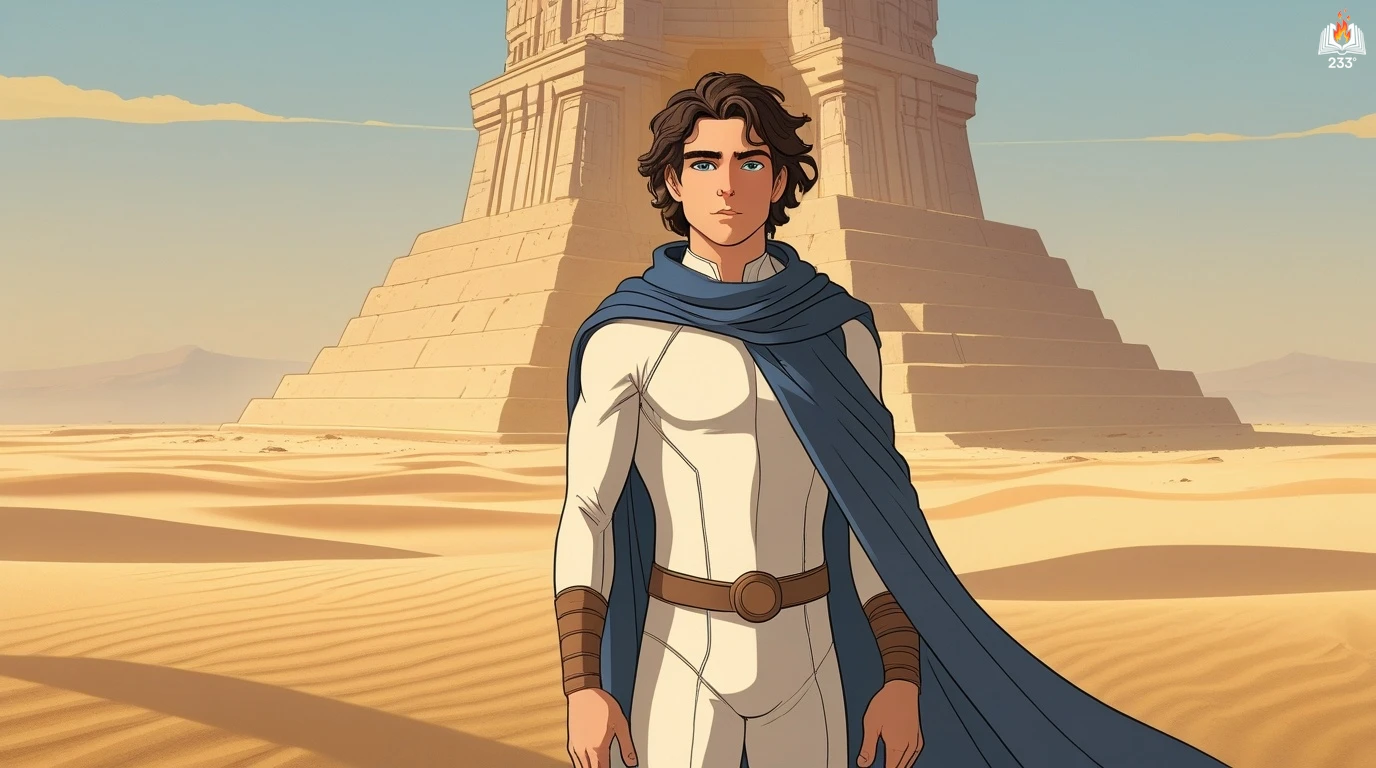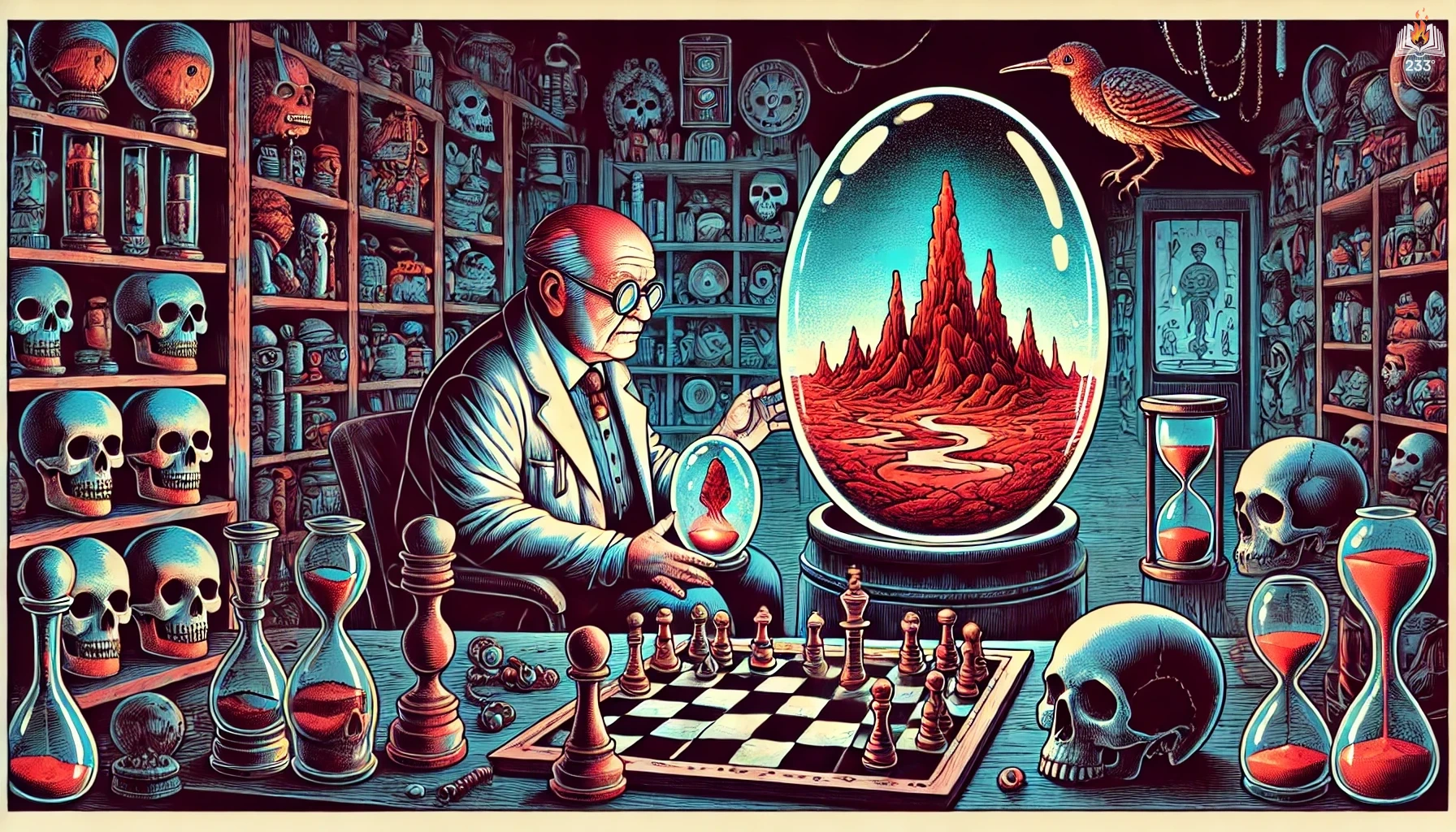Children of Dune by Frank Herbert, published in 1976, is the third book in the iconic Dune series. It continues the saga of the Atreides family on the desert planet Arrakis, focusing on the twin heirs of Paul Muad’Dib as they navigate political conspiracies, religious fervor, and ecological transformation in a universe shaped by prophecy and power.
Plot Summary
On the arid world of Arrakis, the desert planet once called Dune, change stirs in the wind. The children of Paul Muad’Dib, Leto II and Ghanima, heirs to an empire shaped by sand and prophecy, stand at the heart of a world trembling on the edge of transformation. Their father, swallowed by the desert, is a legend now – the preacher, the prophet, the messiah. But legend leaves heavy footprints, and the weight falls squarely on the shoulders of the nine-year-old twins.
The empire forged in blood and spice trembles beneath the rule of Alia, their aunt and regent, whose grip on power tightens with each passing day. Yet behind her regal bearing lurks a sickness of the soul, a corruption seeded in the womb by the spice trance that granted her ancestral memories before birth. The voices of the past gnaw at Alia’s mind, and among them, the most insidious is the spirit of Baron Harkonnen, whose oily whispers twist her will toward tyranny.
In the sietch, where the stone walls remember Fremen chants and the scent of spice-laden air, Leto and Ghanima prepare. Bound not only by blood but by the countless memories of ancestors flowing through their veins, they walk the line between childhood and ancient wisdom. Leto, haunted by prescient visions, understands that the golden path of humanity’s survival runs through sacrifice, but the nature of that sacrifice sharpens with cruel precision. Ghanima, fierce and brilliant, guards him, tethering him to the present even as his mind drifts toward the storm of futures waiting beyond.
Lady Jessica, mother of Muad’Dib, returns from Caladan, her Bene Gesserit training making her a blade of quiet power. Her eyes see what others overlook – the rot at the heart of Alia’s rule, the simmering rebellion among the Fremen, the restless churn of the empire’s soul. She returns not simply as grandmother but as an agent of judgment, walking into the heart of a family and a world she helped shape, with love tempered by the steel of necessity.
Amidst the dunes and palaces, whispers rise. The Preacher roams the land, a blind man wrapped in tattered robes, challenging the worship of Muad’Dib with words sharp as a crysknife. Many believe him to be Paul himself, returned to stir the winds of rebellion. His presence haunts Alia, gnaws at her carefully built facade, and sparks a fire in the hearts of those who have grown disillusioned with empire cloaked in religion.
From beyond Arrakis, Prince Farad’n of House Corrino enters the dance. Born of the defeated imperial line, Farad’n becomes a pawn in a dangerous game. Shaddam IV’s grandson is groomed for revenge, but as his path winds toward the Atreides, his own awakening begins – a mind sharpened by political intrigue, tempered by the hand of Jessica, and molded into something neither enemy nor simple ally.
Plots coil through the empire like sandworms beneath the dunes. Alia, desperate to secure her reign, conspires to bind Leto to her side, pushing him toward a spice trance that would expose him to the same corruption devouring her. The Bene Gesserit, ever-watchful, covet the genetic treasure of the Atreides twins, while the Fremen struggle with a world turning green, a desert tamed and losing its soul.
But Leto, touched by prescience, sees beyond the immediate conspiracies. He understands that Arrakis itself hangs in the balance – the sandworms dwindling as water spreads across the land, the spice flow threatened, and with it, the delicate weave of galactic civilization. He knows that only through transformation, through the acceptance of a destiny almost too vast to bear, can humanity avoid stagnation and collapse.
In a desert ambush, assassins strike at the twins, their knives guided by Alia’s command. Leto fakes his death, slipping away into the deep desert where the sand sings and the sandtrout wait. There, beneath the burning skies, he offers his body to the desert’s oldest secret, merging with the sandtrout to become something new – the first step on a path that will carry him beyond the limits of human life and into myth. The sacrifice is immense, but in Leto’s mind, the survival of the human race outweighs all else.
Ghanima, left behind, cloaks herself in grief and strategy. She moves through the court like a blade hidden in silk, fooling Alia, calming Jessica, drawing Farad’n into her web. Farad’n, guided by Jessica’s steady hand, steps away from vengeance and toward a fragile alliance, his heart reshaped by love for the fierce girl who once seemed an enemy.
Alia’s unraveling quickens. Hounded by the Preacher’s words, tormented by the voice of the Baron in her mind, she teeters on the brink. In a final confrontation at the heart of her crumbling rule, Alia faces the mirror of her own choices. The twin forces of loyalty and rebellion close in – Stilgar, torn between love for his people and his Atreides oath, the Fremen, restless under green skies, and Jessica, who sees her daughter consumed from within. Alia’s fall is not a matter of politics but of soul, the tragedy of a woman who reached too far and lost herself in the voices of the dead.
The Preacher’s death comes not as a triumph or defeat, but as the closing of a circle. Paul Muad’Dib, blinded and weathered by the desert, meets his end with the quiet dignity of one who shaped an age and stepped beyond it. His legacy, however, lives on – not in temples or bureaucracies, but in the living future carried by his children.
As Leto returns, no longer merely human, his body armored by the sandtrout, his mind expanded beyond time, he claims his place beside Ghanima. Together, they forge a peace with Farad’n, a union of houses that promises stability, though the cost is written in the sacrifice of self. Leto steps onto the Golden Path, a course set not for the pleasures of empire but for the survival of the species, a shepherd shaped by the desert, crowned not in gold but in inevitability.
The desert remembers. The sietches endure. And as the winds sweep across Arrakis, now a world of dwindling sands and spreading green, the footsteps of gods and mortals alike are swallowed by time, leaving only echoes in the dunes.
Main Characters
Leto II Atreides: Paul’s son, gifted with ancestral memories and prescient abilities. Leto struggles with the immense burden of shaping humanity’s future and confronts moral dilemmas that push him toward a transformation no other human dares.
Ghanima Atreides: Leto’s twin sister, equally wise and perceptive, she shares her brother’s ancestral awareness. Ghanima is both confidante and counterbalance to Leto, embodying fierce loyalty, compassion, and political savvy.
Alia Atreides: Paul’s sister, acting as Regent. Alia succumbs to “Abomination,” overwhelmed by ancestral voices, especially the malignant spirit of Baron Harkonnen, leading her down a path of tyranny and self-destruction.
Lady Jessica: Paul’s mother, a formidable Bene Gesserit who returns to Arrakis to assess and possibly rein in Alia’s rule. Jessica’s wisdom, discipline, and maternal love make her a powerful force in the unfolding conflict.
Stilgar: Fremen leader and loyal guardian of the Atreides twins. He grapples with old Fremen ideals in a rapidly changing world, torn between loyalty and the survival of his people.
The Preacher: A mysterious, blind prophet believed to be Paul returned from the desert. He challenges the empire’s religious and political establishment with biting truths.
Farad’n Corrino: The grandson of the deposed Emperor Shaddam IV. Initially a pawn in political games, Farad’n’s arc transforms him into a thoughtful, educated leader shaped by the intrigues of the empire.
Theme
Power and Corruption: The novel explores how power, especially religious and political authority, corrupts even those with the noblest intentions. Alia’s descent into tyranny is a stark example, as is the bureaucracy that grows from Paul’s once-pure revolution.
Prescience and Fate: Leto’s and Ghanima’s burden of prescient visions and ancestral memory raises profound questions about free will, destiny, and the price of foreknowledge. The struggle to steer humanity without enslaving it to a predetermined path is central.
Identity and Transformation: Leto’s journey culminates in a physical and spiritual metamorphosis, reflecting themes of sacrifice, loss of self, and the evolution necessary to guide humanity toward survival.
Ecological Change: Arrakis itself is a living symbol of change. The transformation from desert to green paradise threatens the sandworms and the spice cycle, underscoring the unintended consequences of ecological intervention.
Loyalty and Betrayal: The complex bonds between family, tribe, and empire are tested. Stilgar’s loyalty, Jessica’s return, and Farad’n’s awakening all highlight the fragile nature of allegiance in a volatile world.
Writing Style and Tone
Frank Herbert’s writing in Children of Dune is richly philosophical and densely layered, blending intricate political maneuvering with metaphysical inquiry. His use of multiple points of view offers readers deep psychological access to characters, balancing intimate emotion with sweeping historical forces. Herbert’s language is elegant, often poetic, laced with epigraphs, proverbs, and invented religious texts that deepen the novel’s mythic resonance.
The tone is somber, reflective, and at times darkly prophetic. Herbert does not shy away from moral ambiguity, portraying a world where no decision is without sacrifice and no vision is without cost. There’s a palpable sense of dread running beneath the surface, a recognition that the struggle to guide civilization is fraught with peril. Yet moments of warmth and fierce love – especially between Leto and Ghanima – lend a human tenderness to the epic canvas.
We hope this summary has sparked your interest and would appreciate you following Celsius 233 on social media:
There’s a treasure trove of other fascinating book summaries waiting for you. Check out our collection of stories that inspire, thrill, and provoke thought, just like this one by checking out the Book Shelf or the Library
Remember, while our summaries capture the essence, they can never replace the full experience of reading the book. If this summary intrigued you, consider diving into the complete story – buy the book and immerse yourself in the author’s original work.
If you want to request a book summary, click here.
When Saurabh is not working/watching football/reading books/traveling, you can reach him via Twitter/X, LinkedIn, or Threads
Restart reading!








